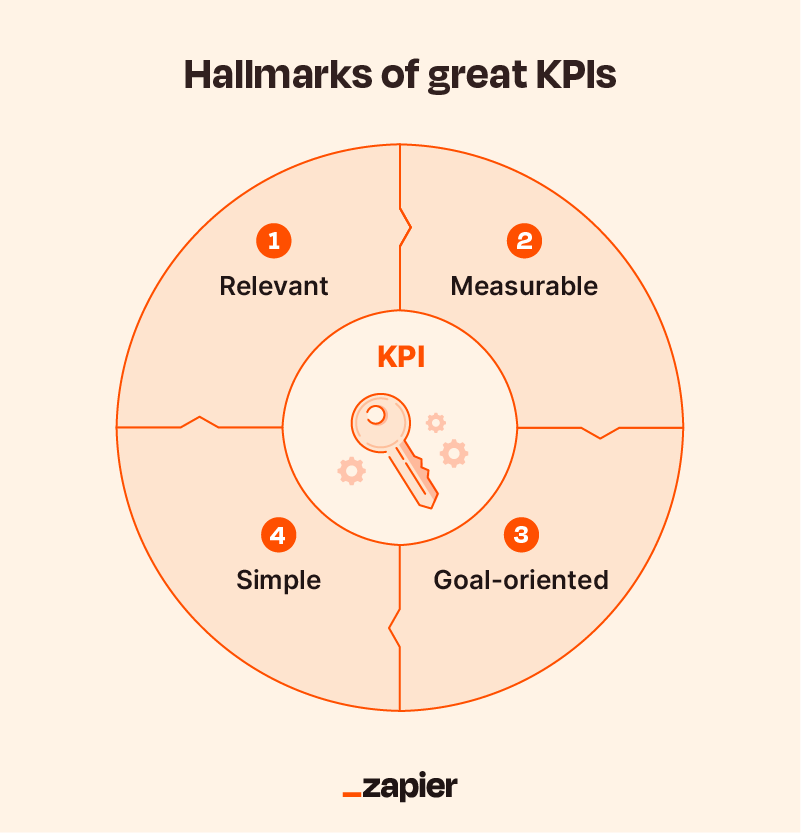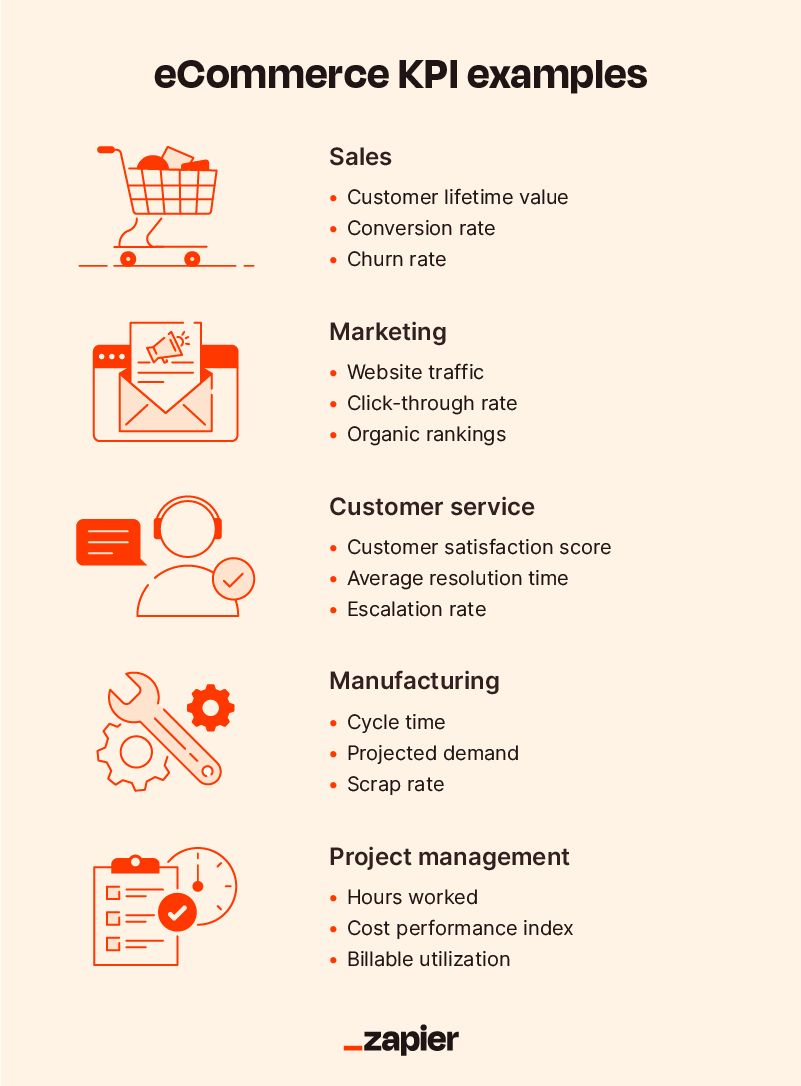The day I got my first "B" on a high school project rocked my world. My heart raced like I had come this close to falling off a cliff. In hindsight, my reaction was a little (very) dramatic. But I was an overachiever, and at the time, a "B" felt like the end of my academic career.
We've all had experience using metrics to track our progress toward goals. In school, grades help us track how well we're learning about certain subjects. In business, these metrics are known as key performance indicators (KPIs). eCommerce companies have to take particular care to set and monitor the right KPIs to ensure they invest their limited resources effectively.
In this guide, I'll unpack 70 common eCommerce KPIs and how to set your own.
Table of contents:
Quick overview: What is a key performance indicator (KPI)?

A key performance indicator (KPI) is a metric that businesses use to easily track their performance toward their most important goals.
As a business professional, you don't have the time to sift through complex equations and data to grok how performance is trending. KPIs should be easy to measure—no rocket science involved. You also shouldn't have too many of them, as this can cause confusion as to what metrics are most important to your business—just a couple will suffice.
For example, a company offering online coding courses may have a goal to get as many new users trying their courses as possible. It may choose the quantity of users signing up for a free trial or trial growth month-over-month as its KPI—both break down the goal into simple, measurable data points.
Why set KPIs for your eCommerce business?
Have you ever heard the famous quote about insanity, defining it as "doing the same thing over and over again and expecting different results"? Businesses set and analyze their KPIs to avoid this—to correct actions that are repeatedly resulting in poor performance.
KPIs themselves don't do this, but they do help you identify when a problem arises so that you can develop a strategy to fix it. When tracked for long enough, they can reveal an organization's progress over time and even help you identify performance patterns. Plus, what better way to show your employees how their work is contributing to business success than presenting them with a clear number?
70 eCommerce KPIs by area of business
Don't just pick KPIs out of a hat. Make sure they're appropriate for your goals.

eCommerce KPIs to measure sales
The following KPIs are great for tracking things like revenue, conversions, and inventory.
Conversion rate: Conversion rate is the percentage of site visitors that actually make a purchase on your site. It shows how well you're engaging site visitors and leading them down the buyer funnel.
Conversion rate = total site visitors / total conversions
Cost of goods sold (COGS): It costs a lot to create a product—manufacturing, distribution, and overhead aren't cheap. Plus, you have to consider employee wages. COGS tells you what this total cost comes out to. The lower you can get this number while still creating a quality product and maintaining happy employees, the better.
COGS = year's initial inventory costs + inventory costs during the year – EOY inventory costs
Gross profit: Use this KPI to track your profit after deducting the costs involved in production and distribution.
Gross profit = total COGS – total sales
Sales: This one shouldn't raise any eyebrows. Depending on your company's size and goals, track sales by the hour, month, or year.
Average order value (AOV): Having a lot of customers is great, but how much money do each of your customers bring in, on average? AOV measures how much the average customer spends per order.
AOV = total revenue / orders
Shopping cart abandonment rate (CAR): Your CAR tells you the rate at which customers are adding items to their carts without checking out. Some solutions to a high CAR might be comparing your cost of items to that of competitors or making the checkout process more user-friendly.
CAR = 1 – (total completed transactions / total shopping carts) x 100
Customer acquisition cost (CAC): If you want to spend less on the customer acquisition process, you can track CAC. Calculate this by breaking your marketing expenses down per customer. Reducing it may involve uncovering inefficiencies in your marketing efforts.
CAC = cost of acquiring customers / quantity of customers acquired
Customer lifetime value (CLV): Customers can bring in a lot of good business over time, but it costs money to acquire and maintain them. CLV tells you how much value a customer brings to your business. You want to increase this number by making your customers happier (and therefore more invested in your brand).
CLV = (customer's annual profit contribution x average years as customer) – initial acquisition cost
Churn rate: Churn rate tells you the speed at which you're losing customers, whether they're canceling subscriptions or no longer using your products or services.
Churn rate = lost customers / total customers at the start
Purchase frequency: Purchase frequency measures how many orders your customers made within a specific time. This can be specific to products or categories to identify high- and low-performing offerings.
Revenue per visitor (RPV): RPV is a measure of how much, on average, someone spends during a visit to your site. To improve this number, troubleshoot your website analytics and brainstorm opportunities to better lead your visitors down the buyer funnel.
Revenue per visitor = total revenue / number of visitors
Repeat purchase rate (RPR): RPR is the percentage of your customers that return for another purchase. If your company sells products that wear out over time or offers multiple products geared toward the same market, you may make RPR one of your KPIs.
RPR = repeat customer purchases / total purchases
Inventory levels: If you sell physical products, it's essential that you know the status of your product inventory. You can use this KPI to track which products you consistently have a surplus of, which sell rapidly, and more.
Product affinity: Some products just complement each other. Product affinity tells you which products are often purchased at the same time. Knowing this can help you develop a cross-promotion strategy, increasing sales and potentially decreasing how much money you devote to advertising.
Competitive pricing: It's important to be vigilant as competitors adapt their pricing strategies. They may quickly shift the market's tide, so be sure to keep your prices competitive with those who offer very similar products and services.
Hit rate: Hit rate is a measure of sales success. Calculate this by dividing a product's total sales by the number of customers that seek information about that product.
Hit rate = total sales / total prospects
eCommerce KPIs for marketing
Measuring marketing KPIs will enable you to better understand customer and site visitor behavior, allowing you to make data-driven decisions to capture more market share.
Website traffic: This metric is the total quantity of users who visit your website. You can track how this KPI changes on a weekly, monthly, or yearly basis.
Mobile site traffic: Nowadays, every website must be designed for mobile use. Monitor your mobile user activity and make usability adjustments as you see fit.
Blog traffic: Filter your traffic view to specifically monitor blog traffic. This will reveal what topics your users are most interested in, guiding marketing efforts and product development.
Average session duration: This tells you how long the average user spends on your website in a single session. For most pages, the more time they spend, the better—as this suggests the user is more engaged with your content. That said, you want to minimize time spent in the checkout stage, as a high number here may result in a higher shopping cart abandonment rate.
Average session duration = total time of sessions / total sessions
Bounce rate: Your bounce rate tells you the percentage of site visitors who only view one page before leaving your site. Work to improve this KPI by keeping users engaged and wanting to learn more.
Bounce rate = total single-page sessions / total site sessions
Pageviews per session: This metric tells you the average number of pages your users view on your site per visit. While you want your users to explore your site, you also don't want them to have to click through eight pages to reach their desired page.
Pageviews per session = total pageviews / total sessions
Clicks: Clicks refer to the number of times users click links. Measuring this KPI will help you determine types of anchor text, ad styles, and button styles that attract the most attention.
Average click-through rate (CTR): CTR is another great way to gauge the effectiveness of link placement and format. It measures the percentage of page visitors who click on a link.
Average CTR = total link clicks / total link impressions
Email open rate: This metric tells you what percentage of your subscribers open an email. If you find that this number is low, consider experimenting with new attention-grabbing subject lines.
Email open rate = email opens / total emails sent
Email CTR: For some, open rate might not be enough. After all, everyone opens some emails without reading them in detail. Email click-through rate tells you what percentage of your subscribers click on a call-to-action link. You can use this metric to show the effectiveness of an email marketing strategy at driving users to your site.
Email CTR = total email link clicks / total email opens
Email conversion rate: One step further than email CTR is email conversion rate. It shows the percentage of subscribers that make a purchase through a link in your email. This email metric is most closely tied to the profitability of your email marketing campaign.
Email conversion rate = total email conversions / total emails sent
Unsubscribes: You can track either month-to-month quantity of email unsubscribes or your unsubscribe rate. Consider implementing a drip campaign or offering an incentive to pull users back in.
Subscriber growth rate: This KPI tells you how quickly new users are subscribing to your newsletter, product or service, etc.
Subscriber growth rate = total subscribers at end of period – total subscribers at start of period / total subscribers at start of period
Social media engagement: Social media marketing is booming, and there are several ways to measure engagement on social media pages. Likes, comments, and impressions are all important metrics to track.
Social media followers: The more followers you acquire, the larger your social media reach. Acquiring one new follower may expand your brand awareness to their friends and even their friends of friends.
Traffic source: If you want your users to enter your site through a certain medium, consider tracking traffic source. This will show you how much traffic is coming from organic search, email marketing, social media, etc.
Pay-per-click (PPC) traffic volume: If you lean heavily on PPC campaigns for your marketing efforts, your PPC traffic volume is a very important KPI to track. It's an indication of how much traffic these campaigns bring to your site.
Organic rankings: Your organic rankings refer to where you fall in search engine results pages (SERPs) when users type a certain keyword. Whether or not you invest heavily in search engine optimization (SEO), it's a good idea to know how you rank for keywords relevant to your industry.
Core Web Vitals: Core Web Vitals are Google's way of quickly judging how user-friendly a website is. These measures mostly detect page load speed and responsiveness to user interaction. Correct any errors or shortcomings to be better rewarded by Google.
Backlinks: Think of backlinks and referring domains as "votes" for your website from other websites. They tell Google that others see your content as better than the rest, resulting in higher rankings.
Reviews: Product reviews tell both Google and other prospective customers more about your product and brand. Having a lot of good reviews can boost your rankings and attract new business.
Revenue from marketing: To ensure your marketing efforts are paying off, you can track how much revenue they bring in. Break this down by initiative, such as content marketing, social media marketing, and email marketing.
Share of voice (SOV): SOV refers to the portion of the market your brand dominates compared to your competitors. It's a good measure of how much people are talking about you.
SOV = your own brand's mentions / total brand mentions
eCommerce KPIs for customer service
Satisfied customers make for a successful business. The following KPIs are great metrics for identifying customer service issues and opportunities.
Customer satisfaction (CSAT) score: CSAT score is usually collected from customer survey responses, the most common question being "How satisfied are you with your experience?" To get a numerical score, answer options should be numerical (e.g., from 1-10).
CSAT = sum of scores / total respondents
Net promoter score (NPS): Your NPS can help you gauge how likely your customers will recommend your brand to the people they know. You can expect those who score themselves highly to function as brand promoters and those with low scores to either avoid sharing about your brand or even speak negatively of it.
Average resolution time: This metric is the average time it takes for your customer support team to resolve a customer's inquiry or issue. A lower time suggests that your team is providing prompt, effective, and customer-centric responses.
Average resolution time = duration of all resolved inquiries / total inquiries
Return rate: If a high percentage of customers are returning purchased items, this doesn't reflect well on your ability to meet customer needs. Keep track of this metric and better study your customers to reduce your return rate.
Return rate = total units returned / total units sold
First response time: This metric is how long it takes you to first make contact with a customer about their inquiry. To ensure that the customer feels well attended to, this time should be as low as possible.
Chat sessions: If you offer a virtual chatbot or a live support feature on your site, you can track the number of sessions that users initiate or even user satisfaction with their experience.
Active queries: This refers to the number of unresolved customer issues in your queue at any given time. You may set a goal to have zero in-progress issues by the end of each week.
Customer service email count: This refers to how many emails your customer service team receives from customers. Typically, the fewer, the better—as this often means fewer customer complaints.
Customer service phone call count: This refers to how many phone calls your customer service team receives from customers. As with email count, the fewer, the better.
Customer service chat count: If you offer a live chat feature on your website, you can also count how many chats customers initiate. Typically, fewer chats mean fewer issues customers are having with your offering(s).
Escalation rate: This metric is the percentage of customers whose complaints reach a higher support tier. For example, the more times customers ask to speak with a manager, this number goes up. You should aim to keep it low.
Escalation rate = inquiries reaching higher support tier / total inquiries
eCommerce KPIs for manufacturing
Setting manufacturing KPIs can help you avoid production inefficiencies, saving you precious resources.
Cycle time: Cycle time refers to the total time it takes to produce a single product, helping you measure your manufacturing process's efficiency. Aim low while still maintaining your product's quality.
Cycle time = production end time – production start time
Throughput: Throughput is a measure of how much a machine or factory can produce over a specific period of time.
Throughput = number of units produced / time
Overall equipment effectiveness (OEE): As the name suggests, OEE is a measure of equipment effectiveness. High OEE scores are a sign of high manufacturing productivity.
Overall labor effectiveness (OLE): Most equipment requires human labor to operate and maintain. OLE is a measure of your machine staff's productivity.
Projected customer demand: By projecting customer demand, you can estimate how many raw materials you'll need to avoid surplus or deficit. Monitoring demand for certain products over time can also help you adjust your offerings.
Projected customer demand = raw materials x production rate
First time yield (FTY): FTY, also known as first pass yield, is the percentage of product units manufactured "perfectly" (to specification) the first time around. It's a KPI used to measure wastefulness in the manufacturing process.
First time yield rate = quality units / total units
Scrap rate: Another metric for waste, scrap rate refers to the percentage of products that have manufacturing defects that can't be corrected (and are therefore considered scrap).
Scrap rate = scrap units / total units
Non-compliance incidents: Manufacturing needs to be safe for staff and customers alike. For this reason, there are a lot of regulations and policies to comply with. Track and attempt to minimize incidents of non-compliance to avoid costly penalties.
Manufacturing cost per unit: It's important to know how much it costs to produce your product in order to calculate your COGS and set the right price for the product.
Manufacturing cost per unit = total manufacturing cost / number of units produced
Overtime rate: Overtime is costly and reflects poor scheduling and staffing practices. Lower your employee overtime rate to save money and to utilize your staff more efficiently.
Overtime rate = overtime hours / regular hours
eCommerce KPIs for project management
Keeping track of team performance when running an eCommerce business isn't easy. Setting project management KPIs can make the lives of managers and other team leads easier.
Hours worked: Especially for project-oriented work, it's essential to track the number of hours it takes employees to complete a task. Compare this number to the hours you schedule for a project to adjust your expectations and better allocate your resources in the future.
Budget: In addition to the hours your employees spend on a project, you should aim to set an accurate and realistic budget for the project and track how far over or under budget it goes. Adapt budget expectations following every project.
Return on investment (ROI): ROI is a critical metric that tells you the payoff of your business's efforts. In short, how much did you get out of what you put in? You want to increase ROI as much as possible.
Change request count: This metric refers to the number of times that a client requests changes to a project or other scope of work. You want to keep this number low, as too many changes can result in resource waste or throw off timelines.
Cancellation count: Sometimes, projects need to be canceled or put on pause. But too many cancellations can point to poor planning and resource waste. You want to keep this metric low.
Cost variance: Cost variance compares your total costs with what you predicted your costs would be. It can help you identify how often your project is within vs. out of your budget. Ideally, your cost variance will be a positive number close to zero.
Cost variance = budgeted costs – actual costs
Schedule variance: Just as you should be mindful of cost expectations vs. reality, you should pay attention to whether your allocated time for a project aligns with how much time is actually spent on it. Get this number as close to zero as possible to avoid wasting time and human resources.
Schedule variance = budgeted time spent – actual time spent
Cost performance index (CPI): CPI is a ratio indicating the value of a resource investment. If you invest more than you get out of it, your CPI will be less than one; if you get out of an investment more than you put into it, your CPI will be greater than one.
CPI = earned value / actual costs
On-time project milestone completions: You want to complete project stages on time. If you don't, you may need to adjust other team members' schedules, meaning the end consumer may pay for any delays.
Billable utilization: Billable utilization refers to the percentage of time spent on a project that gets billed to a client. Billable hours are usually spent working on projects for clients. If your business works on projects for clients, you want your billable utilization rate to be high.
How to use KPIs for business success
Now that I've bombarded you with 70 KPI options, how do you choose and apply the right ones? Here are some important considerations as you mull over your options.
Your industry: Every industry has its own relevant KPIs. If you offer marketing services, you wouldn't need to worry about manufacturing KPIs.
Your business goals: Do you aim to be the best organization in your industry for customer service? For your product's quality? Select KPIs that align with these goals.
Your expectations: Be realistic with the benchmarks you set for each KPI. Aiming too high can burn out employee morale and ultimately isn't helpful. Likewise, setting benchmarks that are really easily attainable doesn't challenge your business to grow.
Your measurement tools and tactics: Lean on data analytics tools to track your performance toward your eCommerce KPIs and be sure to measure them accurately.
eCommerce KPI examples
Here are some examples of KPIs you might choose based on the following goals.
If your goal is to reduce waste by 15%, you may consider the following KPIs:
First time yield
Scrap rate
Change request count
If your goal is to improve user satisfaction with your website by 20%, you may consider the following KPIs:
Pageviews per session
Bounce rate
Reviews
If your goal is to increase sales by 5%, you may consider the following KPIs:
Sales
Conversion rate
Hit rate
Once you have your eCommerce KPIs sorted, focus on what your staff needs to do to achieve them. Then let the rest run seamlessly in the background with the help of eCommerce automation.
Related reading:






